HTC Sensation 4G Review - A Sensational Smartphone
by Brian Klug on July 1, 2011 12:38 AM EST- Posted in
- Smartphones
- HTC
- Android
- Mobile
- HTC Sensation
- MSM8260
Performance
I’ve been skirting around it for no real reason, but the obvious other big important feature on the Sensation is that it’s the first dual core 45nm snapdragon SoC we’ve looked at in a shipping device. The HTC Sensation is built around a 1.2 GHz Qualcomm MSM8260 SoC with Adreno 220 graphics and integrated Previously, we looked at 3D performance on a 1.5 GHz Qualcomm MSM8660 in a Mobile Development Platform, and briefly in our initial hands on preview piece at Uplinq. There, we saw that performance was about where it should be given the difference in resolution between what we had tested (WVGA - 800x480) and the Sensation’s qHD (960x540) display.
The elephant in the room is what CPU performance on MSM8x60 is like. Dual core snapdragon consists of two scorpion cores clocked at up to 1.5 GHz. Anand is going to give a much deeper CPU architecture dive when he looks at the MSM8660 inside the EVO 3D (again, the x in MSM8x60 merely denotes which modem is onboard), but for now I’m going to present all the benchmark results for the Sensation.
First up are our web benchmarks, which primarily test JavaScript and page rendering. We’re still running SunSpider 0.9, though we’ll soon switch to 0.9.1 and report that alongside. JavaScript performance on HTC’s browser isn’t as good as it should be, and I’m a bit disappointed here that things aren’t better. We’ve seen HTC’s browser result in lower scores before, but it still is at odds with what Qualcomm has told me about how closely the two collaborate to optimize V8 for scorpion.
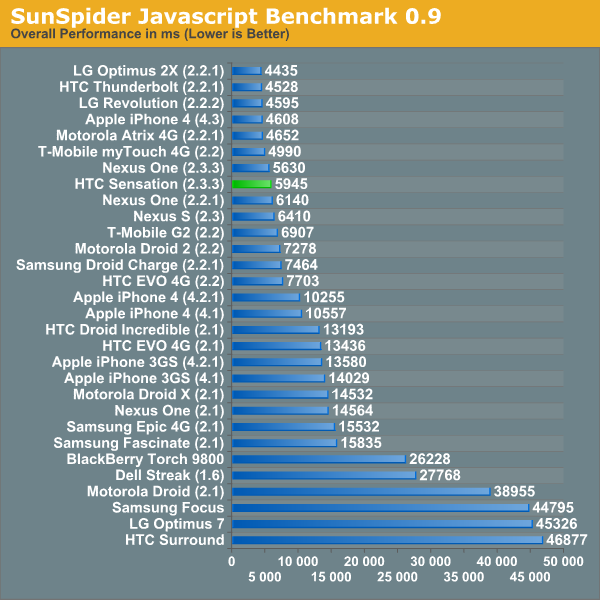
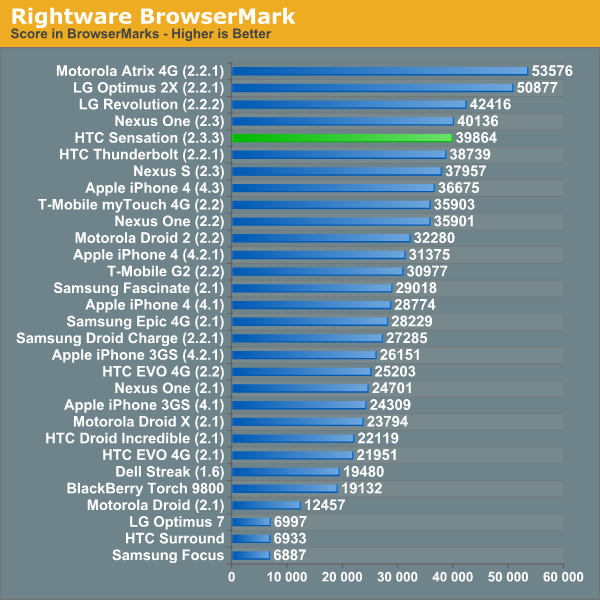
Flash is next, and here the Sensation delivers pretty good performance. It’s hard to make a direct comparison against the Optimus 2X again because we’re dealing with WVGA versus qHD, and we run this test aspect scaled.
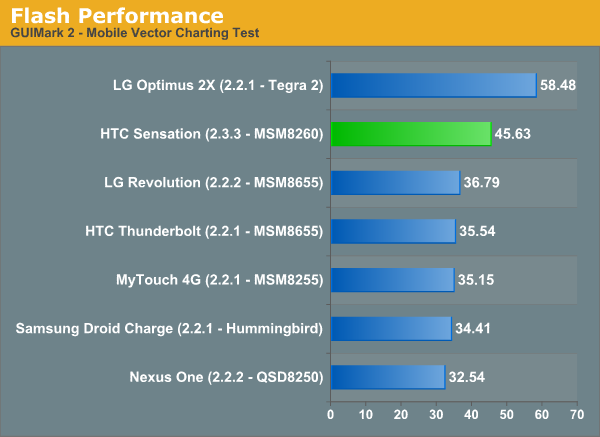
I’m putting Neocore up next because I want to mention again that we’re capped at vsync. We had some hope for a while that we could turn vsync off on handsets, however this is only possible on development hardware, not final ROMs that ship in devices. Odds are you won’t see this pop up again in our suite unless we can make it actually say something. We’re at the Surround’s 60fps wall even at qHD.
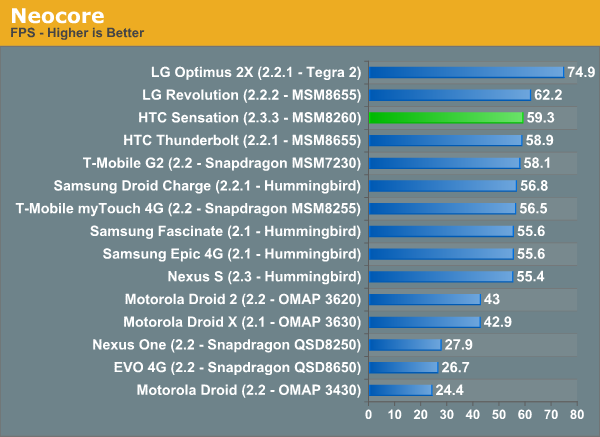
GLBenchmark 2.0 is a mainstay in our benchmarking section, and I’ve already broken down results in our HTC Sensation hands on back at Uplinq. Things have actually improved a bit since that hurried benchmark run over dinner in San Diego, with the Sensation posting around 2fps higher in Egypt and Pro. Again keep in mind the resolution differences between everything here, there’s a 1.35x increase in pixels going from WVGA to qHD.
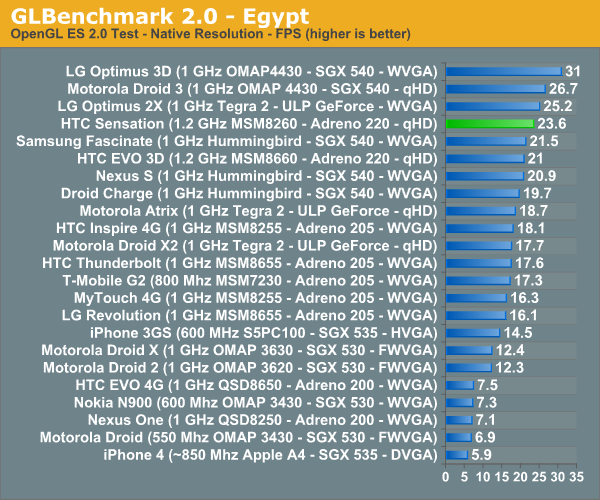
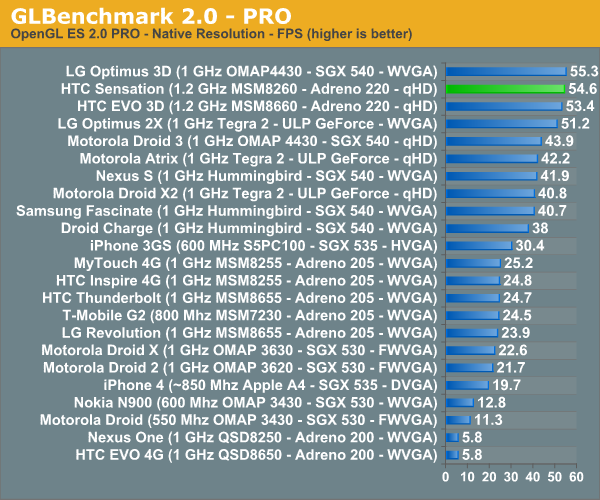
Next is BaseMark ES2.0, which is a nominally updated version of the hugely popular, industry-standard 3DMarkMobile ES2.0. Here we run at the default resolution, which is VGA, and thus get a picture without being constrained to just native resolution constantly. This one is a bit new for us, and I expect that Anand and I are going to explain things a bit more in the EVO 3D story. For now, just take away that MSM8x60 appears very speedy.
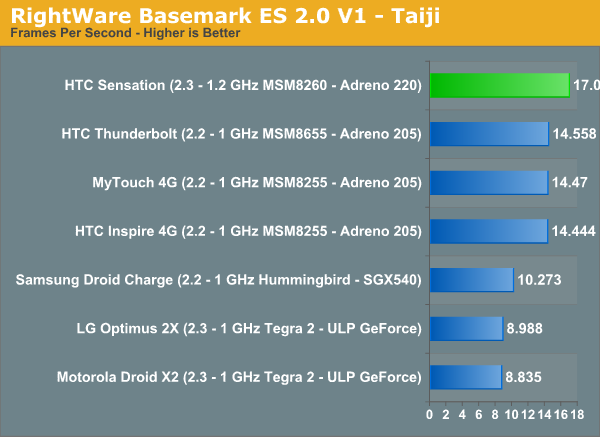
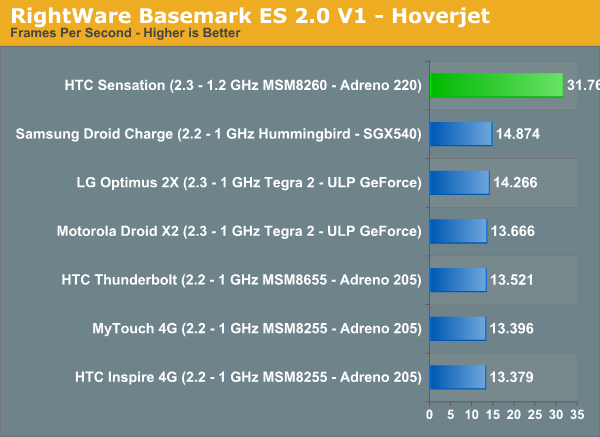
The Android port of Quake 3 is what we sort of started all of this mobile 3D benchmarking with, and we’re still running it even if it’s starting to hit vsync. The results look strange here until you realize that this is again running at native qHD resolution on the Sensation.
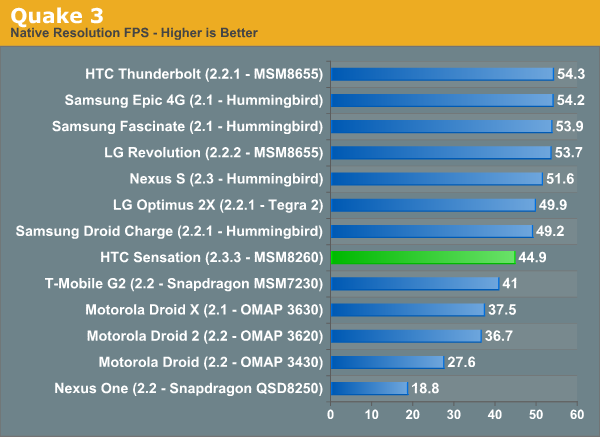
Next up is Linpack, which added a multi-threaded benchmark mode earlier this week. I’ve run it on all the dual core devices I could get my hands on. The initial multi-threaded version had some issues which were fixed on Tuesday, giving more accurate results. We’ll still run the single-threaded version alongside. The 20% jump in clocks shows itself nicely on the Sensation in single-threaded linpack compared to all those 1 GHz MSM8x55 phones we’ve tested.
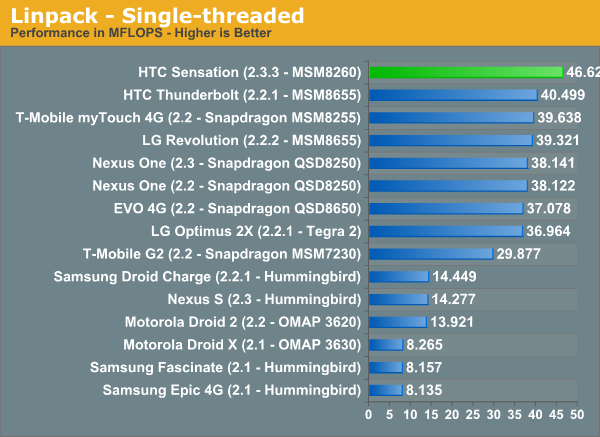
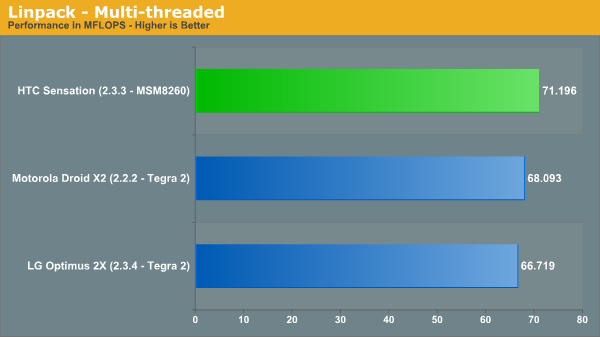
Last and most definitely least is Quadrant, which I think we've gone over our numerous reasons for disliking a few times. The tests themselves are starting to look seriously dated, including 3D tests which render improperly on Android 2.3 and are themselves up against the 60fps vsync cap through their respective runs. I'm sure that the rest of the poorly documented subtests are equally as subpar, however it's become something of a de-facto standard in certain circles.
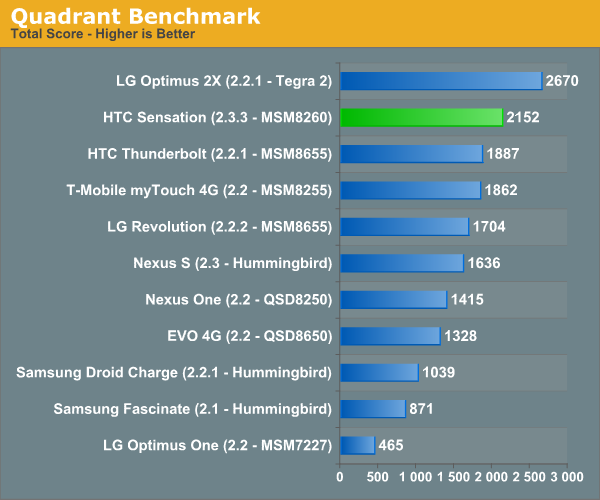
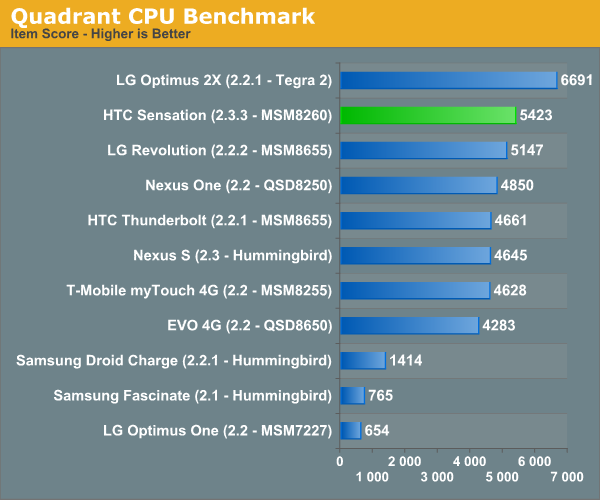
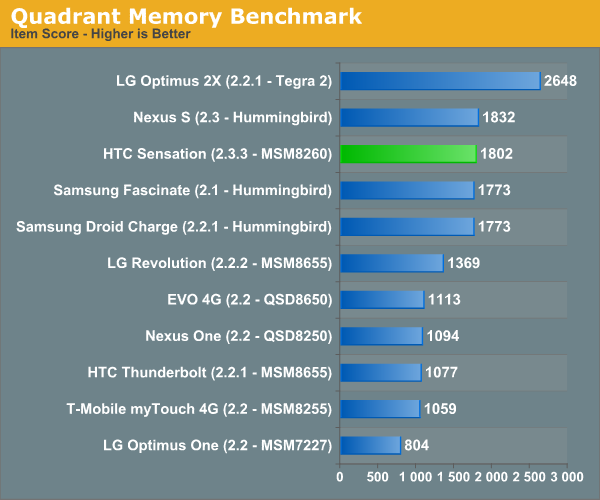
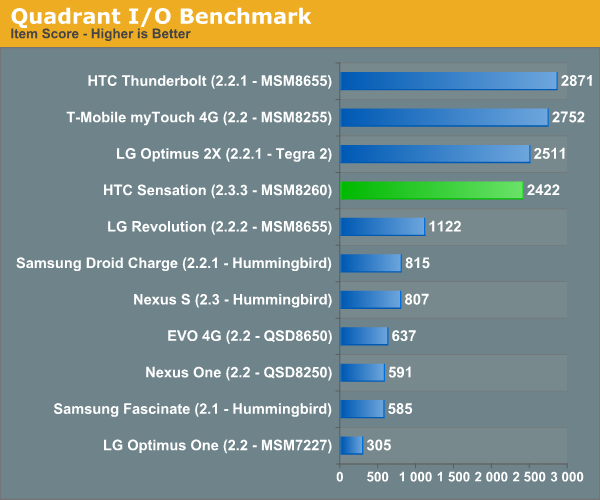
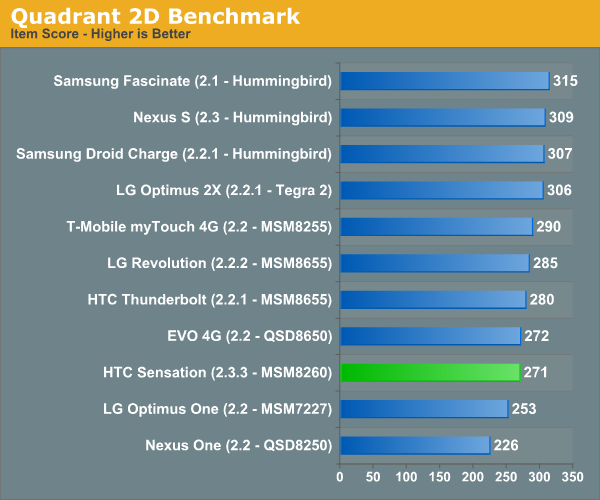
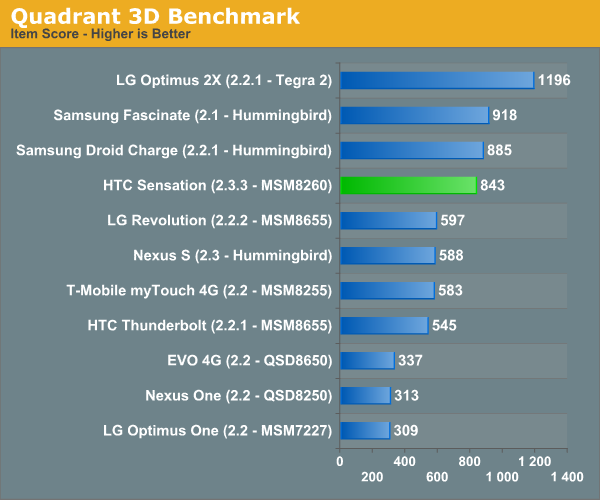
As an aside, I don't think we'll see Quadrant around for much longer, as there are better, more robust, fully documented tools by some established big names coming to the Android market (for free) shortly. All of those will probably quickly and thankfully replace Quadrant, as they all are gunning for its "go-to standard" status as the tool everyone runs, at least from the Android market. I have no doubt they'll quickly succeed.
The state of benchmarking on Android right now is a bit unbalanced, and what everyone wants is a system trace or general use benchmark that will show more than how the CPU does in synthetics and the GPU in synthetics. I fully expect all of that to change this calendar year. Just be patient.










107 Comments
View All Comments
StormyParis - Friday, July 1, 2011 - link
and I was looking forward to getting the Sensation, especially for its big, high-rez screen.I'm thinking of going the Galaxy S 2 route instead:
- GS2 is much lighter (115 vs 150 grams). Less sagging pants and shirt pockets sound really nice (I currently have a 155g HD2)
- screen seems better: fewer pixels, but much better contrast and angles
- Samsung actively supports CM7, I'm not even sure if the Sensation is unlocked (HTC says they're no longer locking, I don't know if originally locked devices get an unlock)
- everything else seems broadly the same. camera maybe a bit better on the GS2
piroroadkill - Friday, July 1, 2011 - link
I personally think the HTC Sensation looks much nicer than the Galaxy S II, and it also provides all 4 Android buttons, which is more useful.Also, Sense 3 is a genuinely nice addition, so I REALLY don't understand the lust for AOSP based ROMs.
I know which phone I'll be recommending if people ask me...
kaworu1986 - Friday, July 1, 2011 - link
I actually registered just to post this, and here it goes:Sense (and the other skins) just need to DIE: they're bloated, ugly and inefficient (not to mention introduce bugs that stock Android does not have); worse than that, they are way of creating vendor lock-in and force users to upgrade hardware by withholding Android updates (a very clever trick to neuter one of the greatest advantages of Android, its open source nature).
Why can't OEMs just stick to do their job? People complain about the crapware OEMs install on PCs (which at least you can uninstall or just format) and somehow this is OK? Also, commodization is exactly what makes the PC ecosystem great: customers can shop around for the best price for their performance needs without having to worry about their devices being left without a software upgrade path or features unavailable. And with phone makers locking their bootloaders the last way of getting out of their death grip, custom ROMs, are being taken away from us.
Finally, I'd much rather rely on software written by a good software company (Apple, MS, Google) with 100s of engineers dedicated to the project than the much smaller team an OEM can afford to put on the job.
piroroadkill - Friday, July 1, 2011 - link
Well, I have a Desire HD, rooted, s-off, I can put whatever the hell I want on it...Oh, and I choose to use a sense based ROM with Sense 3. I've had a phone with pure CyanogenMod, it's all well and good, the point is, as long as the phone isn't horribly locked, and xda-dev get their dirty mitts on it, you can have whatever yo uwant!
piroroadkill - Friday, July 1, 2011 - link
Oh, that said, I don't use the launcher. I use Launcher Pro.Chloiber - Friday, July 1, 2011 - link
Exactly the same here, except I'm using a Desire (non-HD). I really like Sense. I rooted the phone about one year ago and was using Stock Android ROMs a lot. I really liked it. Now I returned to a Sense 2.1-3.0 mix and I like it even more. Some things are simply better with Sense. I also replaced the launcher with LauncherPro (also on Stock Android) because it gives you a really nice, smooth experience. In this regard, pretty much every stock browser, be it Sense or stock Android have failed thus far.@Brian
Strange that Brightness, Airplane Mode and Screen Rotation is missing, as it is included in Sense 2.1 (for example Desire S). But you probably already knew that, as you listed exactly the 3 things that are included there... :-)
shabby - Sunday, July 3, 2011 - link
Aosp ui is pretty archaic compared to touchwiz/sense, it lacks a lot of features that makes the phone more user friendly to the average person.Compare the aosp lockscreen to the sense3 lockscreen, which do you think the average person would want? Compare the widgets from touchwiz4 to the widgets of aosp... oh wait there aren't any in aosp. Catch my drift? Majority of users aren't like you and me that want a plain aosp/cm7 phone, so sense/touchwiz will never die, top selling phones will never be plain google aosp phones because that's not what majority of the public wants.
JasonInofuentes - Monday, July 4, 2011 - link
I think it's important to keep in mind that AOSP was designed with UI modifications in mind. It's not like HTC/Moto/Sammy/LG/Lenovo/Sony got their hands on source and went to work altering it against Goog's wishes. They wanted to be supportive of modifications to the OS from corporations and amateurs alike.Yes, the course was lost as manufacturers delayed updates in order to implement their UI, and some of the UIs were buggy, but then again lots of popular custom ROMS are buggy and users still love them. The point is, if there's value added, which in the case of Sense 3.0 and, by reports, the new Blur then it might be worth the cost to many. But devs should work with Google to make sure that their skins add without being too deleterious. Where I think all OEM devs should back off is in integrating social media streams; unless your implementation is decidedly better than the best social media apps then it's likely going to be a redundant, unwelcome presence.
mikehunt80 - Friday, July 1, 2011 - link
I don't think I've ever used the search button in previous devices, but I guess that's personal preference.I tried out the Sensation before buying the Galaxy S2. There was absolutely no contest. The S2 felt snappier browsing the web (A9 is 25% quicker clock for clock vs. A8/snapdragon), much lighter and nicer to hold without feeling cheap or creaking and I thought the screen on the Sensation was fairly poor in comparison. On top of that the S2 will play absolutely any video you throw at it, I'm told it'll even play 1080p mkvs and my 720p mkv Avatar makes people's jaws drop on the S-Amoled+ screen.
The Sense launcher is nice, but I use Go Launcher EX, which has most of the features of the Sense and is almost infinitely customizable. The Sense lock widgets screen looks nice, but is useless is you use pattern or pin lock.
Both great phones, but the S2 to the more rounded device for me.
piroroadkill - Friday, July 1, 2011 - link
Good point on the video compatibility.It best bloody play 1080p mkv though, since my dirt cheap chinese tablet (<$200) can play 1080p mkv without any pauses.
That's one thing a lot of the top tier devices miss, and I agree that that actually swings things in favour of the Galaxy S II..